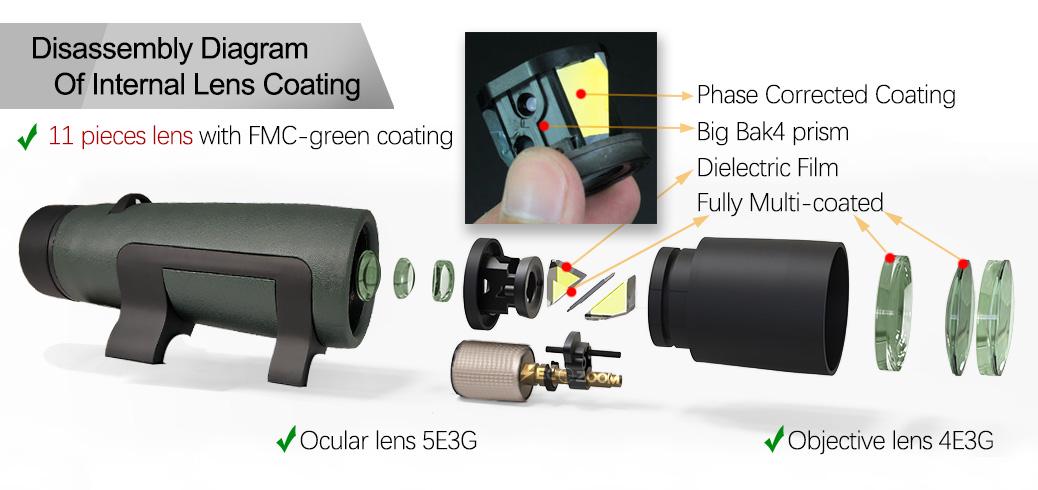Waterproof binoculars are specifically designed for those who frequently use them in outdoor water-related environments. Selecting a pair of waterproof and fogproof binoculars can be challenging—whether they’re for birding, kayaking, or viewing wildlife. With dozens of features and brands available, the process can quickly become overwhelming. Moreover, not all waterproof and fogproof binoculars are built to withstand Mother Nature’s harshest conditions. For most people, the waterproof function of binoculars is rarely needed. However, the waterproof process is not as simple as just nitrogen-filled sealing.
To save you the trouble, we’ve created a comprehensive guide on the features that keep water and fog out. By understanding these key attributes, you’ll be well-equipped to make an informed decision when shopping for waterproof and fogproof binoculars.
Why You Need Waterproof & Fogproof Binoculars
Bad weather, soggy environments, and fluctuating temperatures can ruin a good time outdoors. A compact set of waterproof and fogproof binoculars can save the day, ensuring clear views regardless of the conditions.
For example:
- Observing a rare bird in a moisture-dense forest? Waterproof binoculars are essential.
- Boating in the hot, humid Caribbean? Fogproof binoculars will prevent condensation and maintain clarity.
- You don’t have to worry about rain impact or accidental drops into water while hunting.
- With robust sealing, waterproof and fogproof binoculars are built to handle any weather. Let’s explore the features you should prioritize when choosing the best binoculars for your favorite activities.

What Makes Binoculars Waterproof?
Waterproof binoculars are hermetically sealed using an O-ring, which acts as an airtight barrier to prevent water, dust, sand, and debris from entering. This sealing ensures that your binoculars remain operational even in wet environments. In addition to O-ring sealing, an extra waterproof glass is installed on the outermost layer of the telescope’s objective lens, with the sealing ring actually wrapped around this glass. Sealing rings are also applied to other components such as the eyepiece and hinge positions.
High-quality models also meet specific waterproofing standards, such as IPX ratings, which indicate their resistance to water submersion.

Water Resistance vs. Waterproof
- Waterproof Binoculars: Fully submersible without water intrusion. For instance, some models, like Nocs, are submersible for 30 minutes in up to 3 feet of water.

- Water-Resistant Binoculars: Capable of handling light rain but unsuitable for immersion or heavy exposure to moisture.

Binocular waterproof ratings are typically classified based on international standards.IPX0 – No protection against water.IPX1 – Protection against vertically falling drops (e.g., condensation). Test: 10 min at 1 mm/min rainfall.IPX2 – Protection against dripping water at 15° tilt. Test: 2.5 min per side (4 positions) at 3 mm/min.
IPX3 – Protection against spraying water (up to 60° from vertical). Test: 5 min at 10 L/min, 50–150 kPa.
IPX4 – Protection against splashing water from any direction. Test: 5 min at 10 L/min, 50–150 kPa.
IPX5 – Protection against water jets (6.3 mm nozzle). Test: 3 min at 12.5 L/min, 30 kPa.
IPX6 – Protection against powerful water jets (12.5 mm nozzle). Test: 3 min at 100 L/min, 100 kPa.
IPX7 – Protection against immersion in water (1m depth for 30 min).
IPX8 – Protection against continuous immersion (beyond 1m, as specified by the manufacturer).
Therefore, identifying the waterproof rating of binoculars can help you understand their water resistance performance. Typically, only binoculars labeled as IPX7 can be called waterproof binoculars.
What Are Fogproof Binoculars?
To prevent internal fogging and condensation, manufacturers purge oxygen from the optical barrels and replace it with dry gas, typically nitrogen or helium. The hermetic seal keeps moisture out, ensuring that the lenses remain clear even in high-humidity or temperature-fluctuating environments.
Benefits of Fogproof Binoculars
- Condensation-Free Viewing: Maintain clear visuals in all weather conditions.
- Mold Prevention: Hermetically sealed chambers inhibit mold growth, a common issue with older or poorly sealed binoculars.
- Are All Waterproof Binoculars Fogproof?
No. While all fogproof binoculars are waterproof, not all waterproof models are fogproof. Fogproofing requires the additional step of gas purging.
Anti-fog binoculars are primarily used in high-latitude or cold regions, where frequent temperature changes can cause moisture in the air to condense into water droplets. People who wear glasses are particularly familiar with this phenomenon: when entering a warm room from the cold outdoors, the lenses instantly fog up with water vapor. If you are not a user in these regions, you may consider forgoing this feature, as slight lens mold has minimal impact on observation.
Nitrogen vs. helium Gas: What’s the Difference?
Both nitrogen and helium gases prevent internal fogging by eliminating moisture. However, there are environmental and practical distinctions:
- Nitrogen: More environmentally friendly due to its abundance in Earth’s atmosphere (approximately 79%). Producing nitrogen has a smaller carbon footprint.
- helium: Less common but provides similar fogproofing benefits. Typically used in high-end optics for its stability.
Regardless of the type of gas, failing to ensure a purity level of over 95% will affect a binocular’s waterproof and anti-fog functions. SECOZOOM uses high-purity nitrogen with 99.9% purity for filling, ensuring that the lenses will not develop mold for at least 10 years. Additionally, it employs organic silicone adhesives that are particularly suitable for fixing lens body joints and sealing rings. After organic curing, these adhesives form an elastic rubber layer that fills tiny gaps, preventing water vapor from penetrating. This ensures excellent waterproof performance, allowing the binoculars to remain submerged continuously for 30 minutes at a water depth of 1 meter.

Features to Look For
1.O-Ring Sealing: Ensures airtight protection against water and debris.
2.Gas Purging: Prevents fogging inside the lenses.
3.IPX Ratings: Verify the waterproof standards (e.g., IPX7 for submersion).
4.Durability: Robust materials withstand outdoor challenges.
5.Multi-Coated Optics: Enhance light transmission and image clarity.
6.Compact Design: Lightweight models are easier to carry for activities like hiking or boating.
Top Uses for Waterproof & Fogproof Binoculars
1.Birdwatching: Clear views in forests and wetlands.
2.Boating & Kayaking: Resists water exposure and ensures clarity in humid environments.
3.Wildlife Observation: Ideal for unpredictable terrains and weather.
4.Sports Events: Maintains clarity in all conditions.
5.Hiking & Camping: Durable and portable for outdoor adventures.
Care Tips for Your Binoculars
- External Fogging: Wipe lenses with a non-abrasive, soft cloth.
- Storage: Store in a dry, cool place to prevent mold.
- Regular Cleaning: Use lens cleaning solutions to maintain clarity.
FAQs on Waterproof and Fogproof Binoculars
Are all binoculars waterproof? No. Many models are only weather-resistant, meaning they can handle light moisture but not submersion.
When should I use waterproof or fogproof binoculars? These binoculars are versatile and suitable for activities like hiking, birdwatching, and water sports.
What if my binoculars fog up externally? External fogging can be wiped away with a soft, non-abrasive cloth. This type of fogging is normal and unrelated to the internal fogproofing features.
Should you choose waterproof binoculars?
- As waterproof binoculars require an additional layer of glass, this may affect light transmittance. In severe cases, you may even notice that the field of view of waterproof binoculars appears darker.
- Additionally, you need to pay more for the waterproof function. Please assess whether you will frequently use this feature.
- Over time, the sealing performance may degrade, leading to the loss of waterproof functionality. Issues such as adhesive failure, impacts, extreme temperatures (high or low) can all cause a decline in sealing performance.
Waterproof binoculars recommendation.
This YBRED02 model binoculars, designed in China in 2018, has garnered wide praise among binoculars enthusiasts and is highly recommended as an ideal choice for beginners. It is a Level 7 waterproof binoculars, capable of withstanding submersion at a depth of 1 meter for 30 minutes without water ingress.

Its hollow design is not only aesthetically appealing but also facilitates easy carrying, significantly reducing its weight. Despite this, it still weighs nearly 500 grams due to each barrel featuring an 11-piece glass structure and a large 2.0-specification prism. The structure of 3 groups and 5 pieces enables it to have a large field of view of 114 meters. This design ensures a generously sized 23mm-diameter eyepiece, enhancing user-friendliness and viewing comfort—your eyes won’t feel fatigued even after prolonged use. The multi-coated lenses, including anti-reflective and phase coatings on the prisms, significantly enhance the clarity of the view.
Its eyepiece features a 3-stage helical rise with a distinct tactile feedback, while the focusing wheel—crafted from metal with a textured surface—rotates smoothly, offering a comfortable grip. Notably, the nameplate on the top of the focusing wheel remains stationary during adjustment.

Many customers came to know about this binoculars later, thanks to the promotion by National Geographic.
Therefore, I sincerely hope that you can give it a try and discover its unique features.
Conclusion
Waterproof and fogproof binoculars are indispensable tools for outdoor enthusiasts. Whether you’re hiking through misty mountains or sailing under humid skies, these binoculars ensure crisp, clear views. By investing in a high-quality pair with the right features, you’ll enjoy nature’s wonders without worrying about the elements. Choose wisely, and let nothing cloud your vision!



